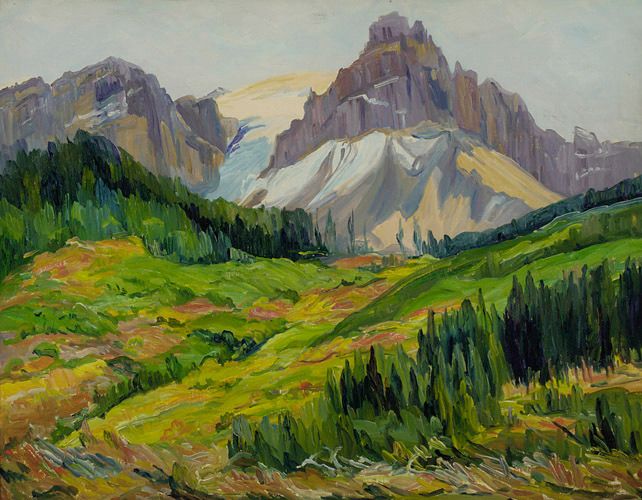As you travel down the winding Yoho Valley Road from Takakkaw Falls towards the peaks of the Canadian Rockies in Yoho National Park, British Columbia, Canada, there is a moment when the waters of the Yoho and Kick Horse Rivers meet. The elevated land opens into a clearing, and the jagged Cathedral Crags rise into view like the stone buttresses of a Gothic cathedral.
This is the dramatic setting in the 1930s, where Mary Butler translated the immensity of the Rockies in paint. With fluid brushstrokes, Butler captures the light, color, and movement of a wild forest that gives way to alpine glaciers and the striking pinnacles of the Cathedral Mountains.
Painting outdoors, or en plein air, Butler was in her element, while also pushing against tradition. At a time when it was rare to see women artist, let alone traveling and working on their own in remote public settings, Cathedral Crag, Yoho Road is also a demonstration her independence.
Born in Pennsylvania in 1868 to strict Quaker parents, Butler was raised in a conservative household that discouraged artistic pursuits for women.
Through persistence, she convinced her parents to let her study at the Philadelphia School of Design for Women, later advancing to the Pennsylvania Academy of the Fine Arts, where she trained under William Merritt Chase and Edward Redfield. She went on to study at Académie Colarossi in Paris, absorbing the lessons of Impressionism and Post-Impressionism.
As one of the few women of her generation to build a career as a professional artist, Butler traveled extensively in Europe, Canada, and the United States, seeking inspiration in the natural world. She painted along coasts, overlooking valleys, and immersed in rugged terrain, attentive to how light shifted across hours and seasons.
At the same time, she was navigating a field dominated by men. Butler became deeply involved in organizations supporting women artists.
Serving as President of the Fellowship of the Pennsylvania Academy of Fine Arts for fifteen years, and working with the Art Alliance and the National Association of Women Painters and Sculptors, among others, Butler organized exhibitions, raised funds, and helped secure visibility for women at a time when opportunities were limited.
This dual commitment—to the landscapes she painted and to the advancement of women artists—defined Butler’s practice. Her work reminds us that art can both capture fleeting moments of beauty as well as serve as an act of defiance.

